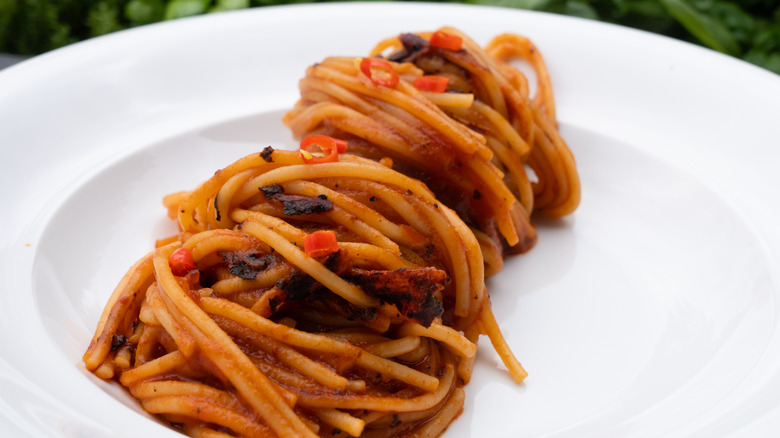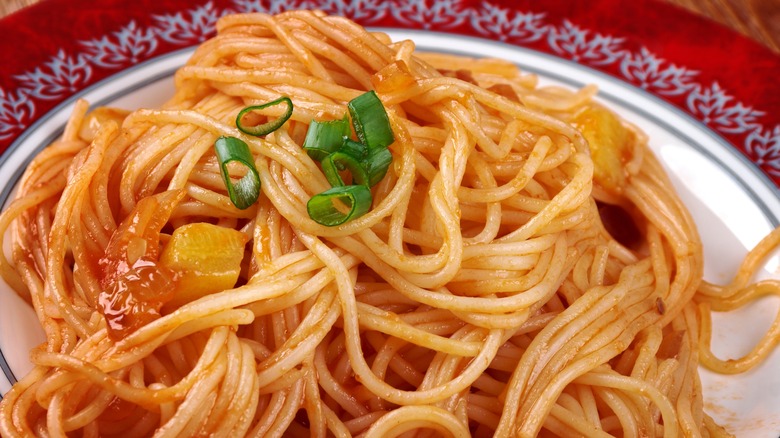How Puglia's Spaghetti All'assassina Got Its 'Killer' Name
Anyone who's traveled in Italy will likely tell you the best part of Italian culture is the "Mangia! Mangia" or "Eat! Eat!" mentality. The culinary world of Italy is an attraction in its own right, experienced with passion and gusto, from morning cornettos and cappuccinos through evening aperitifs with steaming mounds of hand-cut fresh pasta. And it is indeed all about the pasta, regardless of the other gastronomical delights encountered in countless trattorias, ristorantes, tavernas, osterias, and pizzerias from Sicily to Rome, Florence, Milan, Venice, and everywhere in between.
Each region has its own food specialties, most involving some form of pasta. Carbonara and cacio e pepe hail from Rome, while tagliatelle egg noodles with Bolognese sauce is a signature dish of Bologna, explains The Discoverer. Sicilians love pasta alla Norma, and Naples dishes out plenty of ziti and pizza.
But the region of Puglia in southern Italy harbors a lesser-known "killer" pasta that spins its own tales of history, mystery, and downright deliciousness. It's one of the most time-consuming pasta dishes due to a constant need for attention — but those who master the art consider it a badge of honor. According to Eatalian With Roberto, this pasta even has a dedicated academy bearing its name: the Accademia dell'assassina.
A pasta by any other name
What's in a name? A lot, when that name happens to be an Italian dish called spaghetti all'assassina. It stands out for many reasons, not the least being a moniker associated with deliberate murder. Fortunately, spaghetti all'assassina, also known by its chilling nickname of killer spaghetti, has no known history of anyone perishing in its throes. Quite the opposite, as the pasta is a beloved mascot for the city of Bari, the capital of Puglia, where it apparently came to life.
As with most good stories, the origin tale of killer spaghetti has several variations, including the reason for its name. The New York Times relates two word-of-mouth origin stories, the first being a chef who neglected his pasta until the whole thing burned, thus killing it in the pan. The second feasible creation story relies on the "killer" spices in the dish that set many a tongue on fire, depending on the intensity of individual recipes.
Other sources get more specific, including La Cucina Italiana, which shares information from Apulian cuisine historian Felice Giovine. He states that owners of the ristorante Al Sorso Preferito found a handwritten pasta recipe in an abandoned rotisserie adjacent to their building in the 1960s — which evolved into what's now the city's claim to pasta fame: spaghetti all'assassina. As for the killer connotation, La Cucina Italiana says that a quintessential killer pasta must be "burnt, crispy, and spicy," referring to the cooking method, which differs from any other way of making pasta.
A recipe to die for
Regardless of which noodle dish you create, the steaming strings, tubes, or shells start out being boiled, right? Not with killer spaghetti all'assassina! Instead, this dish is cooked like another Italian favorite, risotto i.e., the pasta is cooked slowly in a pan with liquid that's absorbed and replenished over and over again, explains La Cucina Italiana. With killer spaghetti, the chef traditionally uses a large iron pan that accommodates the length of the pasta and can withstand high heat levels.
The New York Times shares a recipe for spaghetti all'assassina that begins with sautéing tomato paste in oil along with fresh garlic and flakes of red pepper, customized for spiciness, known in Italy as "piccante." The pasta joins the oily mixture, with the chef gradually adding small splashes of tomato broth to the pasta. It's a hands-on process, described by La Cucina Italiana as letting the liquid absorb and the pasta sizzle, "caramelize," and stick to the pan before turning and repeating until the pasta is al dente. Each sizzle-fest creates deliciously crispy bits and the dish's signature charred texture and flavor. You could even say it's "to die for."


